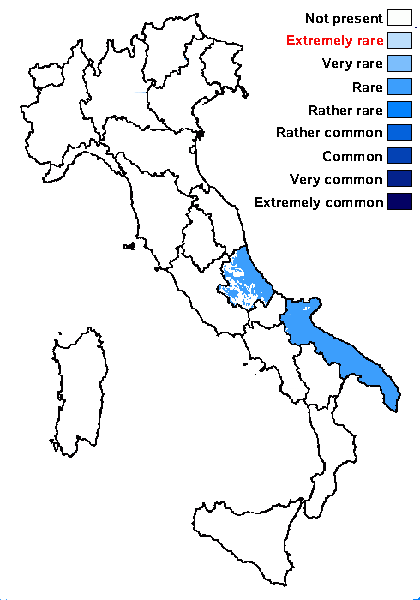Verrucula granulosaria (Clauzade & Zehetl.) Nav.-Ros. & Cl. Roux
in Navarro-Rosinés & al., Bull. Soc. linn. Provence, 58: 157, 2007. Basionym: Verrucaria granulosaria Clauzade & Zehetl. - Nova Hedwigia, 29: 725, 1978.
Synonyms:
Distribution: C - Abr (Nimis & Tretiach 1999, Gheza & al. 2021). S - Pugl (Nimis & Tretiach 1999 as V. latericola).
Description: Thallus crustose, areolate or squamulose-areolate, growing on the thalli of Flavoplaca granulosa. Areoles scattered or forming small clusters, 0.3-1.4(-2.2) mm wide, 0.3-0.5 mm thick, mostly convex, brown to grey-brown, often darker at margins, usually epruinose. Cortex thin, of 1-2 layers of pale brown cells, generally without an epinecral layer; medulla white, at least in part I+ pale blue-violet. Perithecia black, 0.13-0.28 mm across, globose, immersed in the thallus. Involucrellum absent; exciple paraplectenchymatous, colourless except around the ostiole; hymenium colourless, I+ reddish; hamathecium of periphyses along the ostiolar channel, pseudoparaphyses in upper part of the perithecium, and paraphyses disappearing early. Asci 8-spored, clavate, bitunicate, with a thin tholus reacting I-, Verrucaria-type. Ascospores 1-celled, hyaline, long-ellipsoid, (10.5-)13-17(-19.5) x 4.5–6.5(-9) μm. Pycnidia black, immersed, Dermatocarpon-type, c. 0.1 mm across, the wall colourless except at the brown apex. Conidia simple, bacilliform, 4-6 x 1(-1.5) μm. Photobiont chlorococcoid. Spot tests: K-, C-, KC-, P-, UV-. Chemistry: without lichen substances. Note: a lichenicolous lichen growing on the thalli of Flavoplaca granulosa, certainly more widespread.
Growth form: Crustose
Substrata: rocks
Photobiont: green algae other than Trentepohlia
Reproductive strategy: mainly sexual
paras Flavoplaca granulosa
Commonnes-rarity: (info)
Alpine belt: absent
Subalpine belt: absent
Oromediterranean belt: absent
Montane belt: absent
Submediterranean belt: rare
Padanian area: absent
Humid submediterranean belt: rare
Humid mediterranean belt: absent
Dry mediterranean belt: rare

Predictive model
Herbarium samples
Growth form: Crustose
Substrata: rocks
Photobiont: green algae other than Trentepohlia
Reproductive strategy: mainly sexual
paras Flavoplaca granulosa
Commonnes-rarity: (info)
Alpine belt: absent
Subalpine belt: absent
Oromediterranean belt: absent
Montane belt: absent
Submediterranean belt: rare
Padanian area: absent
Humid submediterranean belt: rare
Humid mediterranean belt: absent
Dry mediterranean belt: rare

Predictive model
| Herbarium samples |
 INDEX FUNGORUM
INDEX FUNGORUM
 GBIF
GBIF




